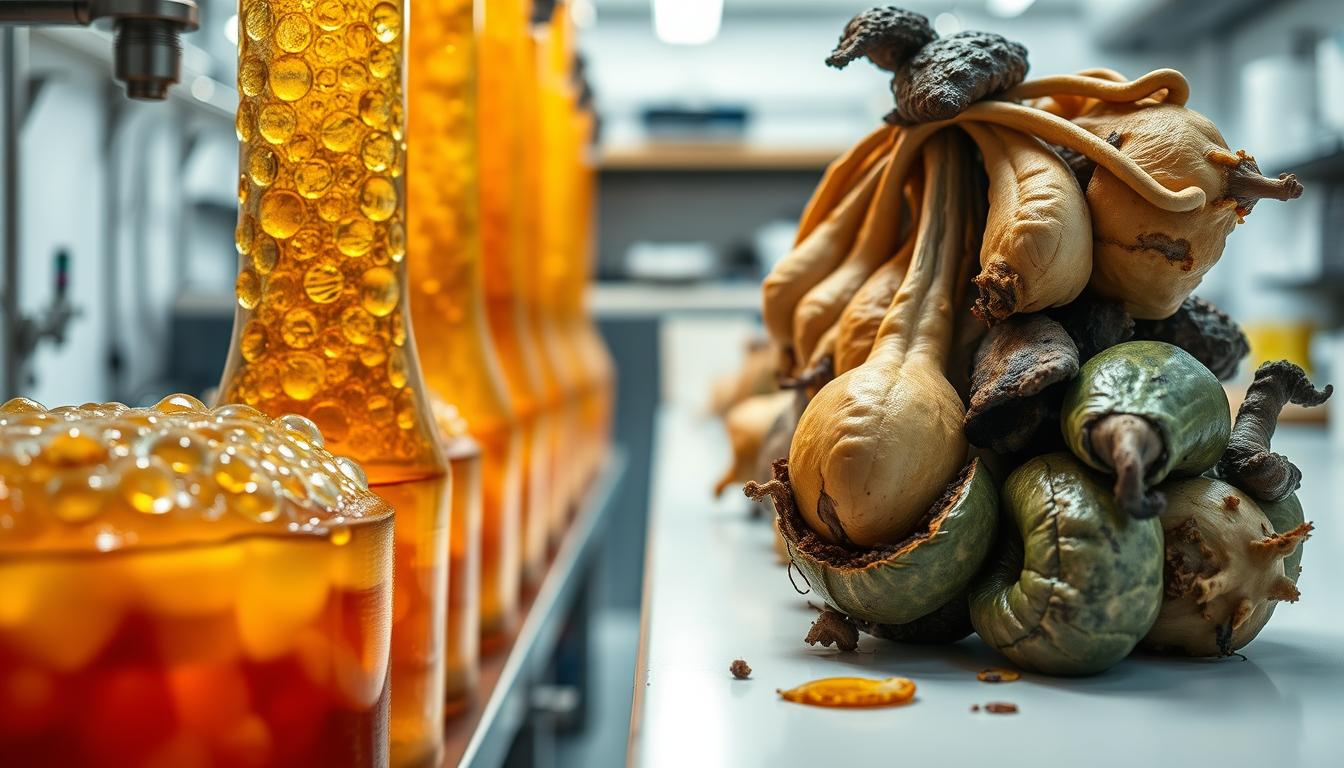Microbes transform your food daily, but only 1% of these transformations create something edible. This invisible battle between helpful and harmful organisms shapes what lands on your plate. While both processes use similar microbial activity, their results couldn’t be more different.
Controlled environments create tangy yogurt from milk. Unchecked bacterial growth turns it into a smelly hazard. The secret lies in which microbes dominate the process. Beneficial bacteria produce acids that preserve nutrients, while harmful ones generate toxins.
Culinary traditions worldwide prove this distinction isn’t just scientific. Korean kimchi and German sauerkraut showcase how cultures harness microbial power intentionally. These practices rely on salt, temperature, and time to guide organic breakdown toward delicious outcomes.
Key Takeaways
- Microbial activity drives both food preservation and decay
- Controlled conditions produce safe, nutrient-rich results
- Cultural practices influence what counts as edible
- Beneficial bacteria create natural preservatives
- Uncontrolled growth leads to dangerous byproducts
- Environmental factors determine microbial outcomes
Recognizing these patterns helps you identify safe preserved foods. You’ll start noticing how acidity levels and storage methods affect your groceries. This knowledge transforms how you approach expiration dates and kitchen experiments.
Understanding the Fundamentals of Fermentation and Spoilage
Your kitchen hosts a microscopic battle where conditions determine whether ingredients become nourishing or dangerous. Controlled environments favor specific beneficial bacteria, while chaotic settings let harmful ones thrive.

The Controlled Power of Microbial Allies
Lactic acid bacteria work like nature’s chefs. They lower pH levels through acid production, creating a hostile zone for dangerous organisms. This science-backed process transforms cabbage into tangy sauerkraut and milk into probiotic-rich yogurt.
“Managing microbial activity is like conducting an orchestra – you choose which players dominate the performance.”
When Unwanted Guests Take Over
Unchecked bacterial growth leaves unmistakable signs. Slimy textures and sour odors signal food has entered the danger zone. Your senses evolved to detect these changes instinctively – that gag reflex? It’s your body’s security system.
| Process | Key Organisms | Result |
|---|---|---|
| Managed Transformation | Lactic acid bacteria | Enhanced nutrition |
| Uncontrolled Breakdown | Pathogenic bacteria | Toxic byproducts |
| Environmental Control | Targeted microorganisms | Extended shelf life |
Notice how preserved items develop pleasant sourness, while spoiled ones smell rancid. This contrast stems from which microorganisms win the survival race in your pantry.
Scientific Breakdown: Microorganisms and Their Roles in Food Transformation
Tiny organisms wage silent wars in your pantry, dictating food outcomes. The outcome depends on which microbial team dominates – those creating edible treasures or dangerous hazards. Let’s explore the science behind these invisible kitchen battles.

Good Bacteria in Fermentation: Lactic Acid and Its Benefits
Lactobacillus strains act as microscopic chefs in your food. They convert sugars into lactic acid through precise biochemical reactions. This natural preservative maintains vitamins while enhancing digestibility.
These salt-tolerant microbes thrive where harmful ones can’t. Brined environments become safety zones, favoring good bacteria growth. The resulting acidic conditions prevent spoilage while developing tangy flavors in kimchi and sauerkraut.
Bad Bacteria and the Process of Spoilage
Dangerous microorganisms take over when controls fail. Spoilage bacteria break down proteins into toxic compounds like ammonia. You’ll recognize their work through slimy textures and putrid smells.
Unlike controlled fermentation, this chaotic process generates harmful byproducts. Consuming these can lead to food poisoning symptoms within hours. Your nose often detects trouble before your eyes do.
| Microbe Type | Primary Action | Food Impact |
|---|---|---|
| Lactobacillus | Converts sugars to lactic acid | Preserves nutrients, enhances flavor |
| Spoilage Bacteria | Breaks down proteins | Creates toxins, causes illness |
| Environmental Factors | Salt concentration, pH levels | Determines microbial dominance |
Notice how controlled acidity creates safer foods? This process demonstrates nature’s balancing act. Proper techniques let beneficial microbes outcompete dangerous ones every time.
The Influence of Environment and Culture on Food Preservation
Salt has been humanity’s silent partner in food preservation for millennia, shaping culinary traditions across continents. This mineral creates selective environments where only desired microbes survive, turning perishables into enduring staples through biological alchemy.

The Role of Salt and Brine in Creating Optimal Conditions
When you submerge vegetables in 2-5% brine, salt pulls water from harmful bacteria’s cell walls. This process lets salt-tolerant beneficial bacteria dominate the ecosystem. Your choice of salt type matters more than you might think:
| Salt Type | Key Feature | Fermentation Impact |
|---|---|---|
| Table salt | Contains anti-caking agents | Can hinder bacterial growth |
| Iodized salt | Includes iodine additives | Inhibits good bacteria |
| Kosher salt | Pure crystals, no additives | Promotes healthy fermentation |
Precision in salt concentration acts like a microbial gatekeeper. Too little allows spoilage organisms to thrive. Too much stalls the process completely.
Cultural Perspectives: How Human Values Distinguish Edible from Spoiled
Your perception of what’s fermented versus spoiled depends heavily on upbringing. Take natto – sticky fermented soybeans beloved in Japan. Many Americans recoil at its strong aroma, demonstrating how cultural exposure shapes food acceptance.
Traditional practices reveal ingenious environmental manipulation. Korean kimchi-makers bury pots in cold ground to slow fermentation. Scandinavian families hang fish in salty sea air. These methods all harness local conditions to guide microbial activity toward delicious outcomes.
“Cultures don’t inherit preservation wisdom – they earn it through generations of edible experiments.”
This knowledge empowers you to reinterpret “expired” foods through both scientific and cultural lenses. You’ll start seeing preservation as a dialogue between nature’s rules and human creativity.
Fermentation vs. Spoilage: What’s the Difference?
Mastering microbial control turns ordinary ingredients into nutritional powerhouses. Proper techniques let you steer organic transformations toward safe, flavorful results. Let’s explore methods that make preserved items both delicious and shelf-stable.
Practical Applications: When and How to Use Fermentation for Food Safety
Creating fermented foods requires controlled conditions. Start with clean equipment and precise salt measurements. For vegetables, 2-3% salt by weight creates an environment where beneficial microbes thrive.
Consider milk’s dual fate. Left uncovered, harmful organisms create foul-smelling waste. Add lactic acid bacteria, and the same liquid becomes tangy yogurt. This transformation demonstrates nature’s balance between risk and reward.
| Milk Condition | Microbial Activity | Result |
|---|---|---|
| Exposed to air | Putrefactive bacteria growth | Food poisoning risk |
| Inoculated culture | Lactic acid production | Probiotic-rich yogurt |
Real-World Examples: Yogurt, Sauerkraut, and Milk Transformations
Shredded cabbage becomes sauerkraut through salt-driven alchemy. Packing layers tightly excludes oxygen, favoring bacteria that convert sugars into preserving acids. Within days, crisp vegetables develop their signature sour taste.
Successful preservation shows clear signs:
- Bubbles indicating active cultures
- Pleasant sour aroma
- Firm texture maintaining structure
These health-boosting creations outlast raw ingredients. Properly stored pickles and kraut stay edible for months, their acidity acting as natural defense. You gain nutritious staples while reducing food waste.
“Every jar of fermented food is a miniature ecosystem where you decide which species survives.”
Recognizing these patterns helps you troubleshoot preservation attempts. Cloudy brines and white sediments often signal success, while colorful molds demand caution. With practice, you’ll confidently create fermented foods that delight the palate and support wellness.
Conclusion
Your culinary creations walk a fine line between transformation and decay. Controlled conditions let good bacteria convert ordinary ingredients into nutrient-rich staples. Unmanaged environments invite spoilage bacteria that compromise safety and flavor.
Even fermented foods require vigilance. Kahm yeast often forms white layers when salinity drops or temperatures rise. While harmless, its presence signals needed adjustments to your process. Bubbling activity within 72 hours confirms successful sugar conversion.
Keep vegetables submerged in brine to maintain anaerobic conditions. Use non-iodized salt at precise concentrations – this protects against mold while encouraging beneficial organisms. Trust your senses: pleasant sourness indicates success, while foul odors demand disposal.
Mastering these techniques empowers you to harness microbial allies effectively. Every jar becomes a testament to balancing nature’s forces with human ingenuity. Your kitchen transforms into a laboratory where science meets tradition, producing health-supporting foods through intentional biological partnerships.



